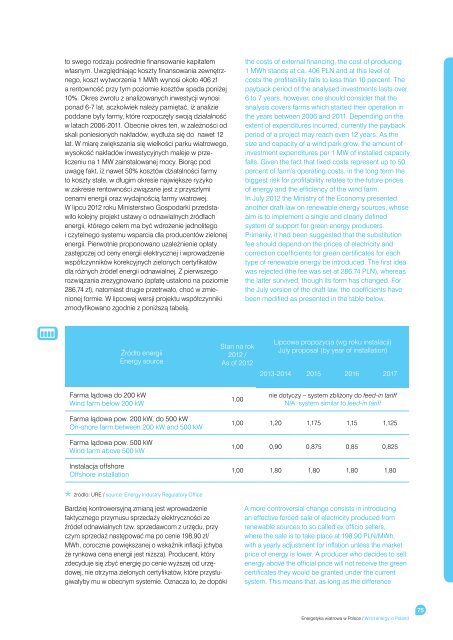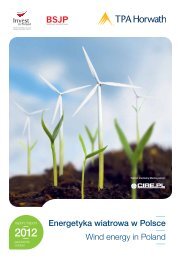Energetyka wiatrowa w Polsce Wind energy in Poland - TPA Horwath
Energetyka wiatrowa w Polsce Wind energy in Poland - TPA Horwath
Energetyka wiatrowa w Polsce Wind energy in Poland - TPA Horwath
You also want an ePaper? Increase the reach of your titles
YUMPU automatically turns print PDFs into web optimized ePapers that Google loves.
to swego rodzaju pośrednie f<strong>in</strong>ansowanie kapitałem<br />
własnym. Uwzględniając koszty f<strong>in</strong>ansowania zewnętrznego,<br />
koszt wytworzenia 1 MWh wynosi około 406 zł<br />
a rentowność przy tym poziomie kosztów spada poniżej<br />
10%. Okres zwrotu z analizowanych <strong>in</strong>westycji wynosi<br />
ponad 6-7 lat, aczkolwiek należy pamiętać, iż analizie<br />
poddane były farmy, które rozpoczęły swoją działalność<br />
w latach 2006-2011. Obecnie okres ten, w zależności od<br />
skali poniesionych nakładów, wydłuża się do nawet 12<br />
lat. W miarę zwiększania się wielkości parku wiatrowego,<br />
wysokość nakładów <strong>in</strong>westycyjnych maleje w przeliczeniu<br />
na 1 MW za<strong>in</strong>stalowanej mocy. Biorąc pod<br />
uwagę fakt, iż nawet 50% kosztów działalności farmy<br />
to koszty stałe, w długim okresie największe ryzyko<br />
w zakresie rentowności związane jest z przyszłymi<br />
cenami energii oraz wydajnością farmy wiatrowej.<br />
W lipcu 2012 roku M<strong>in</strong>isterstwo Gospodarki przedstawiło<br />
kolejny projekt ustawy o odnawialnych źródłach<br />
energii, którego celem ma być wdrożenie jednolitego<br />
i czytelnego systemu wsparcia dla producentów zielonej<br />
energii. Pierwotnie proponowano uzależnienie opłaty<br />
zastępczej od ceny energii elektrycznej i wprowadzenie<br />
współczynników korekcyjnych zielonych certyfikatów<br />
dla różnych źródeł energii odnawialnej. Z pierwszego<br />
rozwiązania zrezygnowano (opłatę ustalono na poziomie<br />
286,74 zł), natomiast drugie przetrwało, choć w zmienionej<br />
formie. W lipcowej wersji projektu współczynniki<br />
zmodyfikowano zgodnie z poniższą tabelą.<br />
Źródło energii<br />
Energy source<br />
Farma lądowa do 200 kW<br />
<strong>W<strong>in</strong>d</strong> farm below 200 kW<br />
Farma lądowa pow. 200 kW, do 500 kW<br />
On-shore farm between 200 kW and 500 kW<br />
Farma lądowa pow. 500 kW<br />
<strong>W<strong>in</strong>d</strong> farm above 500 kW<br />
Instalacja offshore<br />
Offshore <strong>in</strong>stallation<br />
źródło: URE / source: Energy Industry Regulatory Office<br />
Bardziej kontrowersyjną zmianą jest wprowadzenie<br />
faktycznego przymusu sprzedaży elektryczności ze<br />
źródeł odnawialnych tzw. sprzedawcom z urzędu, przy<br />
czym sprzedaż następować ma po cenie 198,90 zł/<br />
MWh, corocznie powiększanej o wskaźnik <strong>in</strong>flacji (chyba<br />
że rynkowa cena energii jest niższa). Producent, który<br />
zdecyduje się zbyć energię po cenie wyższej od urzędowej,<br />
nie otrzyma zielonych certyfikatów, które przysługiwałyby<br />
mu w obecnym systemie. Oznacza to, że dopóki<br />
Stan na rok<br />
2012 /<br />
As of 2012<br />
1,00<br />
the costs of external f<strong>in</strong>anc<strong>in</strong>g, the cost of produc<strong>in</strong>g<br />
1 MWh stands at ca. 406 PLN and at this level of<br />
costs the profitability falls to less than 10 percent. The<br />
payback period of the analysed <strong>in</strong>vestments lasts over<br />
6 to 7 years, however, one should consider that the<br />
analysis covers farms which started their operation <strong>in</strong><br />
the years between 2006 and 2011. Depend<strong>in</strong>g on the<br />
extent of expenditures <strong>in</strong>curred, currently the payback<br />
period of a project may reach even 12 years. As the<br />
size and capacity of a w<strong>in</strong>d park grow, the amount of<br />
<strong>in</strong>vestment expenditures per 1 MW of <strong>in</strong>stalled capacity<br />
falls. Given the fact that fixed costs represent up to 50<br />
percent of farm’s operat<strong>in</strong>g costs, <strong>in</strong> the long term the<br />
biggest risk for profitability relates to the future prices<br />
of <strong>energy</strong> and the efficiency of the w<strong>in</strong>d farm.<br />
In July 2012 the M<strong>in</strong>istry of the Economy presented<br />
another draft law on renewable <strong>energy</strong> sources, whose<br />
aim is to implement a s<strong>in</strong>gle and clearly def<strong>in</strong>ed<br />
system of support for green <strong>energy</strong> producers.<br />
Primarily, it had been suggested that the substitution<br />
fee should depend on the prices of electricity and<br />
correction coefficients for green certificates for each<br />
type of renewable <strong>energy</strong> be <strong>in</strong>troduced. The first idea<br />
was rejected (the fee was set at 286.74 PLN), whereas<br />
the latter survived, though its form has changed. For<br />
the July version of the draft law, the coefficients have<br />
been modified as presented <strong>in</strong> the table below.<br />
Lipcowa propozycja (wg roku <strong>in</strong>stalacji)<br />
July proposal (by year of <strong>in</strong>stallation)<br />
2013-2014 2015 2016 2017<br />
nie dotyczy – system zbliżony do feed-<strong>in</strong> tariff<br />
N/A: system similar to feed-<strong>in</strong> tariff<br />
1,00 1,20 1,175 1,15 1,125<br />
1,00 0,90 0,875 0,85 0,825<br />
1,00 1,80 1,80 1,80 1,80<br />
A more controversial change consists <strong>in</strong> <strong>in</strong>troduc<strong>in</strong>g<br />
an effective forced sale of electricity produced from<br />
renewable sources to so called ex officio sellers,<br />
where the sale is to take place at 198.90 PLN/MWh,<br />
with a yearly adjustment for <strong>in</strong>flation unless the market<br />
price of <strong>energy</strong> is lower. A producer who decides to sell<br />
<strong>energy</strong> above the official price will not receive the green<br />
certificates they would be granted under the current<br />
system. This means that, as long as the difference<br />
<strong>Energetyka</strong> <strong>wiatrowa</strong> w <strong>Polsce</strong> / <strong>W<strong>in</strong>d</strong> <strong>energy</strong> <strong>in</strong> <strong>Poland</strong><br />
75



